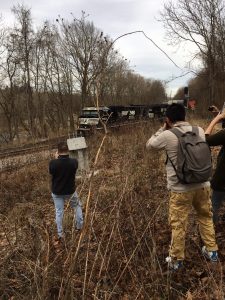Liz Kirchner
Communitnews@ourvalley.org

Glencoe Mansion was built to face the New River and gaze at the rail bridge that crosses it still today.
Now, to tell the stories of the people, land and powers that shaped Radford and the region, the Radford Heritage Foundation, Glencoe Museum and the City of Radford are joining with Virginia Tech architecture students and building materials faculty to build a train-viewing platform that will let the community gaze on that bridge so pivotal in the history of the region.
The project hopes to do at least three things: develop the train tourism of Radford, fostering in-the-field experience among students and demonstrate the use of a new sustainable, locally sourced building material called cross-laminated timber, or CLT.
“We’re interested in telling the story of ‘the journey’,” Deb Cooney, Radford’s tourism director said. “So many Tech students and Radford students, families and trains have come through Radford on their journeys. The themes are endless and the parallels are rich.”
The not-yet designed platform will be sited below the museum (600 Unruh Drive) beside the Cultural Heritage Park along the railroad right-of-way with a view of the bridge and the west end of Bisset Park.
A train crosses the bridge 12 to 15 times a day said Cooney, and train enthusiasts already appreciate Radford’s train heritage.
“We have had steam train excursions from Bristol that have worked out really well. Those events have brought up to 700 train enthusiasts,” she said.
Interesting for its architecture and history, the bridge, part of the most expensive and best-built rail lines in the South.
“The line really changed this region and brought about southern industrialization and two-thirds of the work force that created the line was slave labor,” Scott Gardner, the Director of Glencoe Mansion and the Radford Heritage Foundation said.

In the woods below the Glencoe Mansion, Virginia Tech architecture students photograph a train traveling toward the historic rail bridge on the west end of Bisset Park. Working with Radford City and the Glencoe museum, those students are planning a train-viewing platform to develop the train tourism of Radford, foster practical experience, and demonstrate the use of a new sustainable, locally sourced building material that may fuel regional economic development.
The bridge is one of the longest spans on the line between Lynchburg and Bristol, oddly it was once a covered bridge. Abraham Lincoln mentions it as a key target during the Civil War.
In 1864, the Union came to destroy it, but had forgotten to bring explosives. Instead they set fire to it, but so important in the last gasps of the South’s war effort, it was rebuilt in five weeks. After the war, timber and coal were hauled out on the Norfolk and Western with plans to transform Radford into “The Pittsburg of the South.”
The bridge and the stone piers of a younger bridge beside it are picturesque.
“They’re one of the most photographed sites in Radford, those rail bridges,” Gardner said.
Furthering the theme of journeys, the ten architecture students come to Virginia Tech from India, Iran, China, Syria, Texas and Virginia.
Graduate and undergraduate students, they are in the studio of VT Architecture Associate Professor Kay Edge, a Radford resident, who has sited other community architecture projects in Radford working to foster economic development while training architecture students.
The students will work closely with city zoning and planning departments for real-world experience. Soil testing, erosion and sediment control and safety are paramount to the city, which will do inspections along the way. This is the first time the city has worked with students.
“You’re getting hands on experience. We expect every one of you to have a hammer and a shovel in your hands. This is the real thing,” city inspectors said.
While the viewing platform will be built to serve train enthusiasts, architects and building experts will be drawn to the platform itself.
“We want this project to be a photo-op and an educational opportunity too,” Cooney said.
Using interpretive signage, the project will provide context and information not only on the region’s train and cultural history, but champion the train platform that people will be standing on.
Working with Dr. Edge, Dr. Tom Hammett, professor of sustainable biomaterials, points out the relevance of the use of cross-laminated timber in the project.
“It was music to my ears and talking about sustainability the materials and their importance to the region. Because we’re going to use wood, one of the resources the region provided historically. Wood. Locally sourced wood,” Hammett said. “We’re going to use local indigenous species, yellow poplar. It’s plentiful here and secondly, it’s underutilized. We think of oak and hickory. So we want to look at species found locally.” Yellow poplar is thinned when they’re small to make way for hard mast trees like oak and hickory. CLT panels can be made from these small trees.”
The panels are made in Europe, Canada and the Pacific northwest of the US, but Hammett sees the platform as an opportunity to help the economic development of Virginia.
“These panels could be made here using local material. So, we’re looking for opportunities to use the resources of the region. Plus, it’s a beautiful material. We’re going to experiment with coverings. The project will be educational for all of us,” he said.
The project is slated to finish by May, when many architecture students will graduate, the design-build project is meant to be speedier, but costs are unknowable at this stage. Thirty Thousand dollars is conjectured with $10,000 being sought through crowdfunding campaign online.
Twenty-five dollars will buy 30 board feet of CLT according to the class’s crowdfunding site. Community buy-in is another component of the project.
To participate in this project, visit the crowdfunding page: https://crowdfund.vt.edu/project/8158 through Feb. 28.

